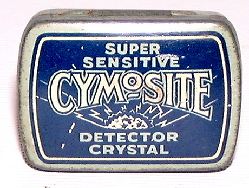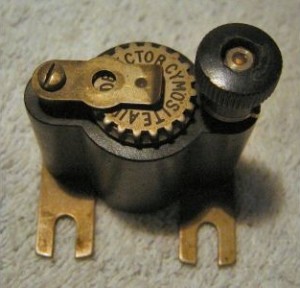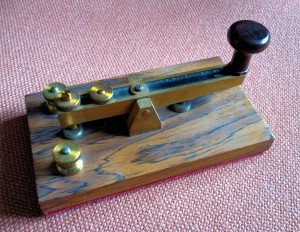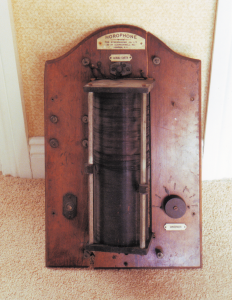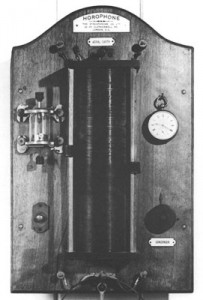This is the story of an old and unique Edwardian radio, the Horophone…type ‘A’ in this case…and how it came to be discovered and shared with the rest of the radio fraternity.
A bit of history first…
In the earliest years of the 20th century, a certain Mr. Norman Hall, set up the North Eastern Instrument Company (NEIC) in Low Fell, Gateshead. It was part of County Durham in those days but is now in Tyne and Wear. NEIC were involved in the manufacture of detector crystals for crystal sets, as well as the sets themselves.
I’ve been unable to track down a picture of one of the sets, but here is a picture of one of the small tins they sold galena crystals in, under the brand name ‘Cymosite’.
They also designed and manufactured a number of revolutionary products, including the Cymosite Automatic Detector shown on the right. I used to have one of these and you turned the black knob, which raised the ‘cat’s whisker’ up and down, whilst rotating a Cymosite galena crystal below it…whilst the whisker was up of course.
This presented a different part of the crystal to the whisker each time it was lowered.
NEIC also manufactured morse keys until World War 2…and I still have the one that was made for me by the late Mr. Sid Hodgson, when I took up amateur radio as a teenager; he was a former very long term employee of NEIC.
NEIC’s morse keys were almost exclusively made for the Ministry of Defence. My key was originally on a simple plywood base, so I made it look a bit nicer by covering the base with wood effect sticky back plastic. It was finished off with red felt on the bottom. It’s actually quite a nice old key, basic but effective. Sid retired from NEIC in 1963 but then went to work for my father for a further six years or so, before poor health forced him to stop.
The radio related work was eventually discontinued as the main interest of the company, as Mr. Arthur Hall had now taken over. The focus changed to the manufacture of switching systems and other mechanical devices, associated with the production of pipe organs worldwide. A major customer was Harrison and Harrison of Durham City, who used their components in the Cathedral Organ. My late father’s company was a supplier to NEIC and I remember many late nights as a child, sitting with my parents assembling hundreds of switches and coils at the kitchen table…the things you need to do to get a business off the ground 🙂
Back to the story…
In 1913 Norman Hall decided to purchase a new device called a ‘Horophone’ direct from its inventor and maker Frank Hope-Jones, who was the founder of the Synchronome Company…there’s lots more about the Hope-Jones brothers and company here.
NEIC set up a subscription service where local jewellers, watch makers or anyone else who needed accurate time, could call them for an exact time as received by the Horophone from the time signals transmitted from Paris.
The Horophone remained at the factory throughout its life until Arthur Hall’s death, at which point the company was closed, and the assets either destroyed or given away. My father did try to acquire the company but even the building was demolished to make way for progress.
My father acquired the Horophone and several other items from the company in 1980, and it lay in his garage until 1991 when he gave it to me…neither of us knew what it was. Some time later I discovered mention of it in Radio! Radio! by Jonathan Hill. The back of the Horophone was missing, as were the detector, watch and headphones. Frankly it needed expert restoration which was beyond my skills. The picture on the right shows it standing against the wall in my hallway.
I decided to advertise the Horophone in RadCom and see what would happen. I had a number of calls, some just curious and many unwilling to commit to an offer. A now rather infamous ‘radio dealer’ came to my house and negotiated the purchase of the Horophone from me…apparently for a mobile museum being assembled by the Marconi Company…ahem, that wasn’t strictly accurate as it turned out 😉
I next saw the Horophone in the 3rd edition of Radio! Radio! and again at the National Vintage Communications Fair in Birmingham. It was great to see it sympathetically restored and still in the UK as part of a private collection. You can read more about the Horophone in Radio! Radio!, but unless my Horophone has a very identical twin, the provenance described is inaccurate…but I suspect it was provided by the ‘radio dealer’.
